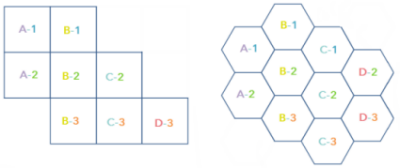 The Generate Tessellations tool creates tessellations, or bins, determined by a specified extent, shape, and size.
The Generate Tessellations tool creates tessellations, or bins, determined by a specified extent, shape, and size.
Workflow diagram

Examples
For reforestation projects, foresters need to divide harvested areas into bins or regularly shaped areas to understand the amount of seedlings and resources needed to reforest the area effectively. Generate Tessellations can be used to automatically create a dataset of appropriately sized bins for the full study area.
A cartographer has dense point-based data and would like to present the data in a map that can be visually appealing and easily understood. Using the Generate Tessellations tool, the cartographer can create regularly shaped areas that the points can be aggregated and summarized into. When added to a map, the cartographer can symbolize the summarized data appropriately to convey the story.
An archeologist has discovered an ancient burial ground that contains many valuable artifacts and historical treasures. To record each found artifact, a grid of tessellated features is created to cover the entire study area to index and record the precise location of all artifacts.
Usage notes
The Use current map extent parameter is disabled forGenerate Tessellations. The extent of the tessellations that will be generated is determined by the Define Extent parameter, which can be the current map extent, the extent of an existing layer, or the extent of an interactively drawn study area.
The output features contain a GRID_ID field. The GRID_ID field provides a unique ID for each feature in the output feature class. The format for the IDs is A-1, A-2, B-1, B-2, and so on. The letters in the IDs represent the columns and the numbers represent the rows, as shown in the following image:

The size of each tessellation feature or bin can be calculated by specifying a value to represent the area for each bin in square units or by specifying a distance value. The distance is calculated as follows, where d is the value of the distance parameter:

How Generate Tessellations works
The tessellations or bins are generated in a custom, area-preserving projected coordinate system using the specified size dimensions to ensure the sizes are equal and appropriate for the area of interest. An appropriate equal-area projection and parameters are chosen based on the specified geographic extent. The result is projected to Web Mercator for display (the default) or to the projection of your custom basemap. A Web Mercator projection may cause your results to appear distorted, especially for large bins or bins near the polar regions. These distortions are part of the display only and do not reflect an inaccurate analysis.
Similar tools
Use Generate Tessellations to create tessellations determined by a specified extent, shape, and size. Other tools may be useful in solving similar but slightly different problems.
Map Viewer analysis tools
If you are trying to aggregate points or summarize features within a tessellated grid, Aggregate Points and Summarize Within have built in options to create tessellations.
ArcGIS Desktop analysis tools
Generate Tessellations performs the function of the Generate Tessellations tool.